Oct 9, 2024
The grand Former Command House
National monuments of Singapore: Former Command House
What is a National Monument? Who gazettes them? How many national monuments are there in Singapore? To date, the Preservation of Sites and Monuments, a division of National Heritage Board, has identified and gazetted 75 buildings, structures and sites of national significance as an integral part of Singapore's built heritage.
In this edition, we put under the magnifying glass the residence of a former Speaker of Parliament, and one of Singapore's presidents, the Former Command House.
The Former Command House was the 59th building to be gazetted as a National Monument. The MRT stations nearest to it are Botanic Gardens and Stevens.
Significant dates
Date built:
1937-1938: Former Command House was constructed at 17 Kheam Hock Road
Milestones:
1970: Dr Yeoh Ghim Seng, Singapore's 5th Speaker of Parliament, moved into the residence
1996-1998: It was the temporary residence of then-President Ong Teng Cheong
Date gazetted: Nov 11, 2009
The grand Former Command House is situated close to Bukit Timah Road, a significant thoroughfare (main road) constructed in the mid-19th century, which served as one of the last lines of defence against the advancing Japanese troops during the Japanese Occupation (1942-1945).
Its significance in Singapore's military history is substantial, particularly at the onset of the Second World War in Asia during the late 1930s and early 1940s.
Erected around 1937 to 1938, the Former Command House was initially known as Flagstaff House. Its original purpose was to serve as the official residence for the General Officer Commanding (GOC) of Malaya, then Lieutenant-General (Lt. Gen.) Sir William G. S. Dobbie.
The construction of the house was also likely part of the British military's strategic measures to strengthen Singapore's defences in anticipation of potential Japanese attacks.
Prior to the moving in of the GOC, Flagstaff House had already hosted a notable event. On Sept 7, 1938, the biggest military wedding reception (at the time) of Lieutenant O. C. S. Dobbie, the son and aide-de-camp (military aide) of Lt. Gen. Dobbie, and Miss Florence Mary Dickey was held at Flagstaff House, following their marriage at Tanglin Garrison Church (now known as Saint George's Church).
Lt. Gen. Dobbie was later succeeded by Lt. Gen. Sir Lionel V. Bond, who acted as GOC until Lt. Gen. Arthur E. Percival took over in May 1941.
Near the Second World War, as the threat of conflict grew, the vicinity around Flagstaff House was transformed into a military base known as Sime Road Camp, which served as the headquarters for the Royal Air Force in Singapore. A Combined Operations Headquarters for the British Army and Air Force was later established at the camp.
In the lead-up to Singapore's fall to the Japanese, the workload intensified, prompting then-GOC Lt. Gen. Percival to forgo returning to Flagstaff House for sleep and instead stay at Headquarters.
On Feb 11, 1942, Sime Road Camp was abandoned in favour of an underground bunker (today known as the Battle Box) at Fort Canning. In the days leading up to the British surrender on Feb 15, Sime Road Camp and the area surrounding Flagstaff House experienced some of the most intense fighting between Allied and Japanese forces.
During the Japanese Occupation, Flagstaff House was repurposed as quarters for Japanese soldiers, while Sime Road Camp functioned as a temporary internment camp for prisoners of war.
Following the war, Flagstaff House was returned to the British administration. In 1946, Admiral Lord Louis Mountbatten, who officially accepted the Japanese surrender at the Municipal Building, had also resided at the house. When British forces withdrew from Singapore in the 1970s, the property was handed over to the Singapore Government.
In 1970, Dr Yeoh Ghim Seng became Singapore's Speaker of Parliament, and Flagstaff House was designated as his official residence. After Dr Yeoh's retirement in 1989, Tan Soo Khoon was appointed his successor.
However, he preferred to reside with his family at his own home; the Urban Development and Management Company rented the property, which eventually became known as the Command House, likely in reference to its previous role as the GOC's residence.
During extensive renovations to the Istana from 1996 to 1998, the Command House served as the residence for then-President Ong Teng Cheong. As a trained architect, Ong contributed to the restoration of the Command House, which saw the addition of a reception hall suitable for state functions.
In 2007, the building was transformed into the UBS Wealth Management Campus — Asia Pacific, serving as a training and conference facility aimed at educating UBS employees and clients throughout the region. By 2010, it was rebranded as the UBS Business University.
While UBS' tenancy has ended, the former residence is currently managed by the Singapore Land Authority.
Design and architecture
The identity of the architect behind the Former Command House remains uncertain; some believe it might have been Frank W. Brewer, who also designed the Former Cathay Building.
The design of this British colonial residence was significantly influenced by the Arts and Crafts Movement, which emphasised craftsmanship and looked down on the inferior quality of industrialised mass-produced goods.
This architectural style was particularly prevalent in the British Empire around the turn of the century. Another example of an Arts and Crafts style building in Singapore is the Former Admiralty House.
A distinctive characteristic of this architectural style is the use of exposed materials, as seen in the brick arches adorning the façade of the Former Command House.
Notably, the building features a "butterfly plan", so-named for the way the side wings connect to the central structure at an angle — a layout popularised during the Victorian era.
Before air-conditioning became common, large windows and doors facilitated natural ventilation throughout the house.
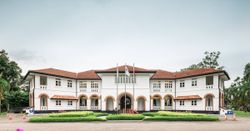


Former Command House
The stately Former Command House is located near Bukit Timah Road, a major road constructed during the mid-nineteenth century and one of the last defences against the invading Japanese troops in 1942. Its role in Singapore’s military history was of paramount importance, especially at the dawn of the Second World War in Asia in the late 1930s and early 1940s.
Flagstaff House
Built circa 1937 to 1938, the Former Command House was originally known as Flagstaff House. It was intended to be the official residence of the General Officer Commanding (GOC) of Malaya, who was at that time Lieutenant-General Sir William G. S. Dobbie. The house was likely constructed as part of the British military’s strategic plan to bolster Singapore’s defence in light of possible Japanese offensives. Even before the GOC moved in, the new Flagstaff House had already hosted its first major event: the grand wedding reception of Lieutenant O. C. S. Dobbie – son and aide-de-camp of Lieutenant-General Dobbie – and Miss Florence Mary Dickey after the matrimonial ceremony at Tanglin Garrison Church (Saint George’s Church today). In end October 1938, the GOC finally left the old Flagstaff House at Mount Rosie and shifted into the new premises on Kheam Hock Road.
Lieutenant-General Dobbie was succeeded by Lieutenant-General Sir Lionel V. Bond, who served as the acting GOC before Lieutenant-General Arthur E. Percival assumed the position in May 1941. Shortly after Percival’s appointment, Air Vice-Marshall Conway W. H. Pulford – the Royal Air Force’s Officer Commanding – also moved into Flagstaff House.
Second World War
As the threat of war loomed closer, the area surrounding Flagstaff House was developed into a military base called Sime Road Camp, which housed the Royal Air Force Headquarters in Singapore. A Combined Operations Headquarters for the British Army and Air Force was subsequently established at the camp. Due to the immense amount of work to be done in the days preceding the fall of Singapore to the Japanese, Percival no longer returned to Flagstaff House to sleep but simply stayed over at the Headquarters.
On 11 February 1942, Sime Road Camp was vacated in favour of the underground bunker at Fort Canning. In the days before the British surrendered on 15 February, Sime Road Camp and the area surrounding Flagstaff House witnessed some of the fiercest battles between the Allied and Japanese forces. During the Japanese Occupation (1942–1945), Flagstaff House was used as the Japanese soldiers’ quarters, while Sime Road Camp became an interim internment camp for prisoners-of-war.
Flagstaff House was returned to the British Administration after the war. Admiral Lord Louis Mountbatten, who formally accepted the Japanese surrender at the Municipal Building, had also stayed in the house in 1946. When the British troops withdrew from Singapore in the 1970s, the ownership of Flagstaff House was entrusted to the Singapore Government.
Official Residence in Singapore’s Post-Independence Years
In 1970, Dr Yeoh Ghim Seng (杨锦成) became Singapore’s Speaker of Parliament, and Flagstaff House was assigned to be his official residence. Yeoh retired in 1989, and Tan Soo Khoon (陈树群) was appointed his successor. As the latter preferred to stay with his family in his own house, the Urban Development and Management Company rented the building. The spacious property later came to be known as the Command House, probably in reference to its past as the GOC’s residence.
When the Istana underwent extensive renovation from 1996 to 1998, the Command House served as the residence of President Ong Teng Cheong. Ong, who was a trained architect, played a role in restoring the Command House to its former glory. A reception hall, where state functions may be held, was added to the house.
Architecture and Furnishings
It is not certain who the architect of the Former Command House was; some suggest it could have been Frank W. Brewer, who was responsible for designing the Former Cathay Building. The design of the British colonial residence was heavily influenced by the Arts and Crafts Movement, which placed much emphasis on craftsmanship and was essentially a revolt against the poor quality of industrialised mass production. It was a style that was particularly widespread in the British Empire at the turn of the century. Another house in Singapore designed in the Arts and Crafts style is the Former Admiralty House.
One of the main characteristics of this architectural style is the use of exposed materials, evident in the facing brick arches on the façade of the Former Command House. An interesting feature of the building is its ‘butterfly plan’, so named because the flanking side wings are connected to the core structure at an angle. This plan was popularised during the Victorian period. Before the advent of air-conditioning, large windows and doors ensured that the rooms in the house were well ventilated.
Former Command House Today
Presently, the former residence is managed by Singapore Land Authority.
Our National Monuments
Our National Monuments are an integral part of Singapore’s built heritage, which the National Heritage Board (NHB) preserves and promotes for posterity. They are monuments and sites that are accorded the highest level of protection in Singapore.
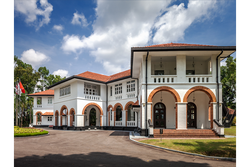
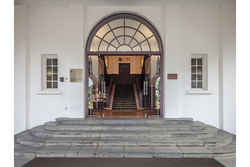
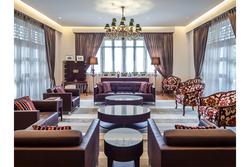
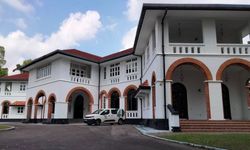
By undefined
9 notes ・ 1 views
English
Intermediate